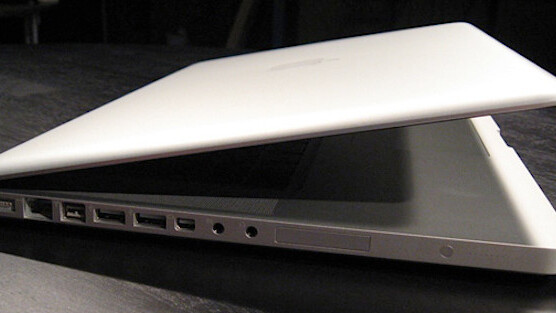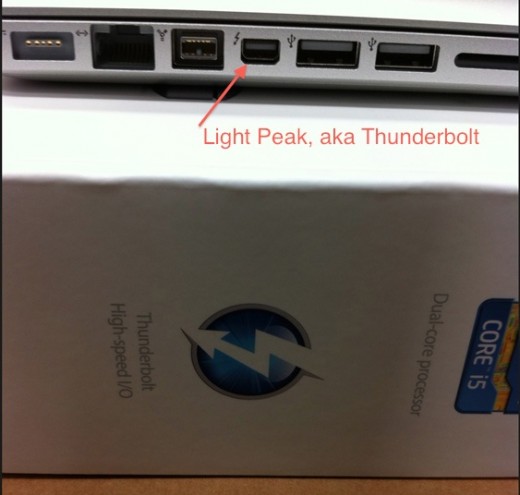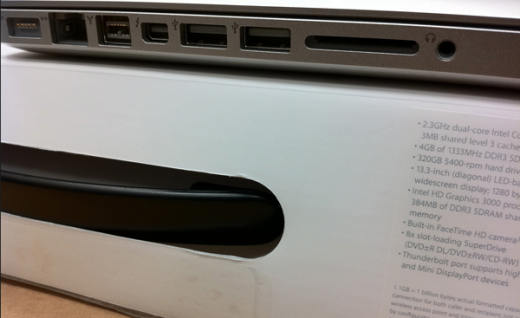
In case you’ve not yet seen us write about it, Apple is in the midst of a slew of rumors right now. The latest of these is about the refresh that’s coming to the MacBook Pro. While Apple has been predictably mum on the subject, we’ve gotten our hands on a couple of great photos thanks to 9to5Mac and so it’s time to start talking.

Why Do You Care?
It’s worth noting that right now, you don’t. If you go out today and try to buy a Light Peak peripheral, you’re going to be sorely disappointed. They simply don’t exist on the consumer market just yet. You will care, though, when they are.
If you remember a few years ago, we though that the idea of USB was magical. The ability to have a high-speed, hot-pluggable interface was going to be life-changing, especially for portable computers. As ubiquitous as USB has now become,here are limitations to it. These are the things that Light Peak is hoping to solve.
Fact: Light Peak is a bus that will allow you to daisy-chain numerous devices to it, across multiple formats. Quite like what we do presently with a USB hub, each of these devices will run as if it were a native part of your computer. However, Light Peak has a much greater throughput ability — presently at 10 Gbit/sec, but up to 100 Gbit/sec in theory — than even the newly-minted USB 3.0.
That speed, in real-world relation, means that you could transfer a 4 GB file (the size of a 1080p movie) in roughly 4 seconds. It is incredibly, mind-blowingly fast by today’s standards.
What Can It Do?
This is where things get a bit tricky. In its first iteration — the 10 Gbit/second version — Light Peak will be great for connecting multiple peripherals. What it likely won’t do, however, is replace every cable that you have plugged into your computer.
Ideally speaking, we’d eventually get to the point where a single Light Peak hub could run everything that you have sitting on your desk, up to and including your monitor. Intel’s Victor Krutul has stated that, while HDMI and DisplayPort chipsets exist inside of Light Peak, it is not Intel’s intention to take over that sector of the market. Not being ones to take kindly to conventional wisdom, though, Apple seems to have opted to replace its Mini DisplayPort with the Light Peak technology, judging by the pictures.

It’s worthy to note, though, that Krutul does lay out a scenario whereby a Light Peak-connected dock could allow a light and battery-miserly laptop while on the go to become a powerful workstation at home. The power-hungry items such as high end graphics could be housed in the dock, with Light Peak connecting it to the base computer. This is not so far off, considering how we presently have a performance-switching model in the MacBook Pro line.
So for now, what we’d like to see are Light Peak hubs that would enable you to replace your present USB hub, while offering the ability to add in Light Peak peripherals as they become available. By now you’ve seen how fast an SSD is. Take a moment to consider an external SSD, that isn’t bogged down by the speed ceiling of USB 2.0, or even 3.0, as it’s worth noting that Light Peak’s 10 Gbit/sec is still twice as fast as USB 3.
The new MacBook Pro, from what we’re seeing, will likely ship with an adaptor to make the Light Peak (Thunderbolt) port of some use. What we’re hoping that we’ll see, in the not-so-distant future, is a hub that would allow you to plug in an HDMI or DVI monitor, then have the extra ports necessary to run your other peripherals as well.
For now, just know that the addition of Light Peak into Apple’s lineup will indeed shake up the market. While it’s an Intel product, and thus likely to end up in other computers quite soon, Apple has the first one on the market and will be setting the pace for what can be done with it.
Get the TNW newsletter
Get the most important tech news in your inbox each week.



